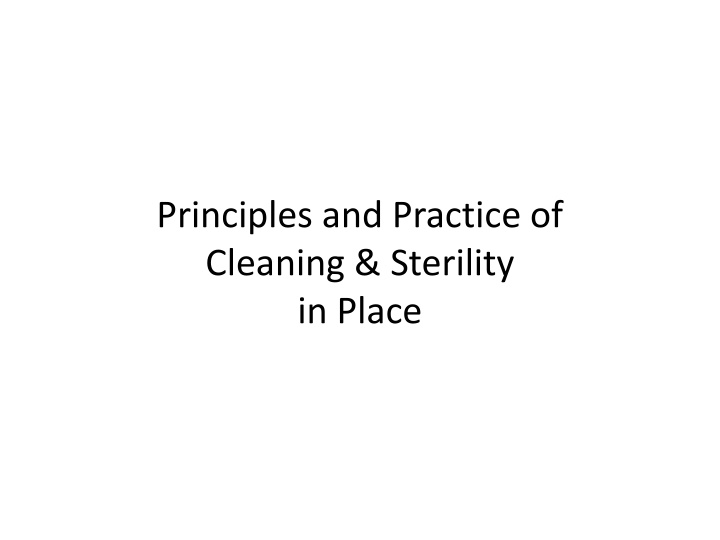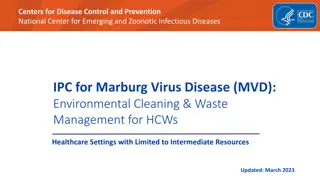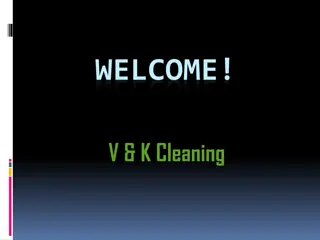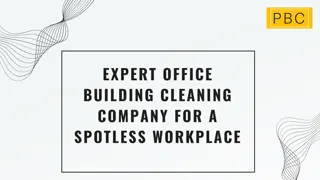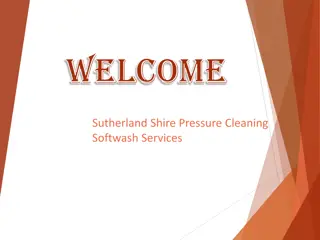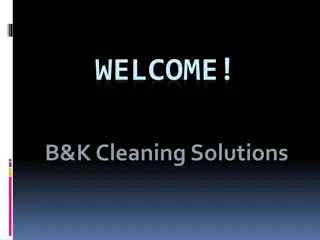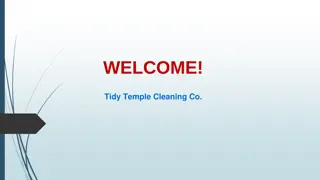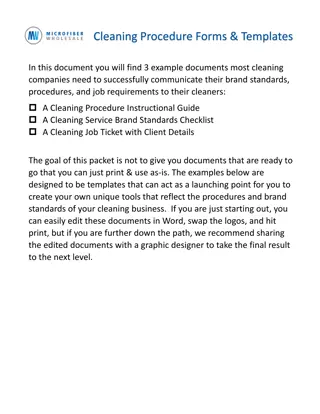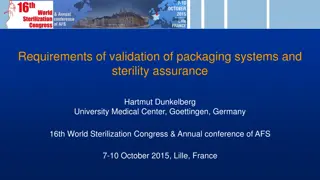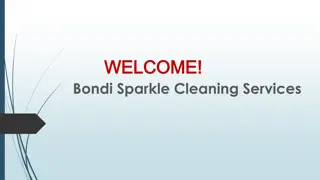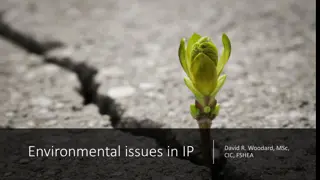Principles and Practice of Cleaning and Sterility in Place
Cleaning in Place (CIP) and Sterilize in Place (SIP) are essential processes in large-scale industries where equipment and vessels are cleaned and sterilized without dismantling, ensuring product safety and quality. CIP involves the use of chemicals, sterilizers, and high-pressure equipment, while SIP focuses on ensuring product contact surfaces are sterile to minimize contamination risks. These practices help maintain cleanliness, eliminate organic contaminants, and reduce microbial growth, ultimately contributing to product quality and safety.
Download Presentation

Please find below an Image/Link to download the presentation.
The content on the website is provided AS IS for your information and personal use only. It may not be sold, licensed, or shared on other websites without obtaining consent from the author.If you encounter any issues during the download, it is possible that the publisher has removed the file from their server.
You are allowed to download the files provided on this website for personal or commercial use, subject to the condition that they are used lawfully. All files are the property of their respective owners.
The content on the website is provided AS IS for your information and personal use only. It may not be sold, licensed, or shared on other websites without obtaining consent from the author.
E N D
Presentation Transcript
Principles and Practice of Cleaning & Sterility in Place
What is CIP? CIP or in its full form, Cleaning in Place is defined as: Equipment and techniques to allow cleaning or process equipment without dismantling or manual cleaning with minimal operator involvement.
CIP / SIP - Definition CIP = Cleaning in Place To clean the product contact surfaces of: vessels, equipment and pipework in place i.e. without dismantling SIP = Sterilize in Place To ensure product contact surfaces are sufficiently sterile to minimise product infection.
CIP / SIP Involves the use of: Chemicals Sterilizers High pressure pumps Spray nozzles Spray balls Aseptic designs
CIP or SIP Ensures that the large scale processes are: Free of dirt Free of organic contaminants Free of microorganisms
5/27/2008 W Wh ha at t i is s C CI IP P? ? W Wh ha at t i is s C CI IP P? ? C CI IP P o or r i in n i it ts s f fu ul ll l f fo or rm m, , C Cl le ea an ni in ng g I In n P Pl la ac ce e, , i is s d de ef fi in ne ed d a as s E Eq qu ui ip pm me en nt t a an nd d t te ec ch hn ni iq qu ue es s t to o a al ll lo ow w c cl le ea an ni in ng g o of f p pr ro oc ce es ss s e eq qu ui ip pm me en nt t w wi it th ho ou ut t d di is sm ma an nt tl li in ng g o or r m ma an nu ua al l c cl le ea an ni in ng g w wi it th h m mi in ni im ma al l o op pe er ra at to or r i in nv vo ol lv ve em me en nt t . . Benefits of CIP B Be en ne ef fi it ts s o of f C CI IP P? ? B Be en ne ef fi it ts s o of f C CI IP P? ? R Re ep pr ro od du uc ci ib bl le e, , R Re ep pe ea at ta ab bl le e, , V Va al li id da at te ea ab bl le e a an nd d C Co on nt tr ro ol ll la ab bl le e R Re es su ul lt ts s R Re ed du uc ct ti io on n o of f C Cl le ea an ni in ng g T Ti im me e I In nc cr re ea as se ed d p pr ro od du uc ct ti iv vi it ty y t th hr ro ou ug gh h r re ed du uc ct ti io on n o of f d do ow wn n t ti im me e C Ch he em mi ic ca al l H Ha an nd dl li in ng g R Re ed du uc ct ti io on n S Si im mp pl le e O Op pe er ra at ti io on n C Co os st t a an nd d U Ut ti il li it ty y S Sa av vi in ng gs s i in nc cl lu ud di in ng g c ch he em mi ic ca al ls s, , w wa at te er r a an nd d e ef ff fl lu ue en nt t l la ab bo ou ur r t ti im me e e et tc c w wa at te er r a an nd d e ef ff fl lu ue en nt t, , l la ab bo ou ur r t ti im me e e et tc c. . H He ea al lt th h a an nd d S Sa af fe et ty y B Ba at tc ch h T Tr ra ac ce ea ab bi il li it ty y a an nd d R Re ec co or rd ds s S St tr ro on ng ge er r C Ch he em mi ic ca al ls s a an nd d h hi ig gh he er r t te em mp pe er ra at tu ur re es s c ca an n b be e u us se ed d E En nv vi ir ro on nm me en nt ta al l I Is ss su ue es s a an nd d L Le eg gi is sl la at ti io on n 2
Benefits, contd. It is: Automatic Reproducible Reliable Delivery of: Cleaning solutions Rinsing Washing To & through: process equipment/piping Improves: Product quality Plant hygiene
How CIP Works? Mechanical Removes loose particles by Impact / Turbulence Chemical Breaks up /removes remaining particles, if possible, by Chemical action Sterilant/Sanitizer Kills remaining micro-organisms to an acceptable level
5/27/2008 C CI IP P E En ne er rg gy y S So ou ur rc ce es s C CI IP P E En ne er rg gy y S So ou ur rc ce es s M Me ec ch ha an ni ic ca al l M Me ec ch ha an ni ic ca al l T Ti im me e T Ti im me e C Ch he em mi ic ca al l C Ch he em mi ic ca al l T Te em mp pe er ra at tu ur re e T Te em mp pe er ra at tu ur re e CIP Energy Solutions 5/27/2008 T Te em mp pe er ra at tu ur re e T Te em mp pe er ra at tu ur re e C CI IP P E En ne er rg gy y S So ou ur rc ce es s C CI IP P E En ne er rg gy y S So ou ur rc ce es s M Me ec ch ha an ni ic ca al l M Me ec ch ha an ni ic ca al l T Ti im me e T Ti im me e E Ef ff fe ec ct t o on n c cl le ea an ni in ng g o op pe er ra at ti io on n: : S So oi il l P Pr ro ot te ei in ns s F Fa at ts s S Su ug ga ar rs s S Sa al lt ts s T Te em mp pe er ra at tu ur re e T Te em mp pe er ra at tu ur re e E Ef ff fe ec ct t m me ed di iu um m g go oo od d C Ch he em mi ic ca al l C Ch he em mi ic ca al l g go oo od d g go oo od d Note : Generally a 10 C temperature increase will improve cleaning efficiency by 50% (above 30 C) T Te em mp pe er ra at tu ur re e T Te em mp pe er ra at tu ur re e E Ef ff fe ec ct t o on n c cl le ea an ni in ng g o op pe er ra at ti io on n: : S So oi il l P Pr ro ot te ei in ns s F Fa at ts s S Su ug ga ar rs s S Sa al lt ts s E Ef ff fe ec ct t m me ed di iu um m g go oo od d g go oo od d g go oo od d Note : Generally a 10 C temperature increase will improve cleaning efficiency by 50% (above 30 C) 4 4
Factors affecting CIP Mechanical Chemical Temperature Time
CIP Operation PRE-RINSE - Mechanical Removal DETERGENT - Cleaning of Remaining - Caustic, Acid or Both FINAL RINSE - Wash Residual Detergent STERILANT/SANITIZER - Cold or Hot
Typical CIP Times Vessel CIP Mains CIP Pre-Rinse 10 to 20 mins 5 to 10 mins 30 to 45 mins 20 to 30 mins Caustic Detergent 10 to 15 mins 5 to 10 mins Rinse 20 to 30 mins 15 to 20 mins Acid Detergent 15 to 20 mins 10 to 15 mins Rinse 10 to 15 mins 5 to 10 mins Sterilant
Typical CIP Temperature Initial (Rx) Vessels Hot 85 C Initial (Rx) Mains Hot 85 C Process Vessels Cold < 40 C Process Mains Hot 75 C (Yeast) Vessels Hot 75 C (Yeast) Mains Hot 75 C
Water Used for Cleaning Process Quality of Water used for aqueous cleansing is critical for performance: Chemical properties (pH, hardness, etc.) Biological properties (bioburden, endotoxins) Pre-Rinsing. Solely for flushing out of residue prior to washing step. Usually based on practicality of what water is available. Washing. Most critical water hardness effects efficiency of cleansing of aqueous surfactant solutions. Rinsing. In general, the final rinse used for equipment should use the same quality of water as used in the final stage of manufacture.
CIP Detergent - Requirements Effective on target Non foaming or include anti-foam Free rinsing Non corrosive Vessels/pipes, joints Controllable - Conductivity Environmental
Caustic Detergents Advantages Excellent detergency properties when formulated Disinfection properties, especially when used hot. Effective at removal of protein Auto strength control by conductivity meter More effective than acid Cost effective Disadvantages Degraded by CO2 forming carbonate. Ineffective at removing inorganic scale. Poor ability to rinse. Not compatible with Aluminium Activity affected by water hardness.
Acid Detergents Advantages Effective at removal of inorganic scale Not degraded by CO2 Not affected by water hardness Lends itself to automatic control by conductivity meter. Readily rinsed Disadvantages Less effective at removing organic soil. Limited bio-cidal properties High corrosion risk, Nitric Acid Environment Phosphate/Nitrate discharge
Detergent Additives Sequestrates (Chelating Agents) Materials which can complex metal ions in solution, preventing precipitation of the insoluble salts of the metal ions e.g. EDTA (Ethylene Diamine Tetra Acetic acid) Surfactants (Wetting Agents) Reduce surface tension allowing detergent to reach metal surface.
Sterilant / Sanitizer Requirements Effective against target organisms Fast Acting Low Hazard Low Corrosion Non Tainting (An unpleasant odour and flavor) Acceptable Foam Characteristics
Sterilants / Sanitizers Chlorine Dioxide Hypochlorite Iodophor Acid Anionic Quaternary Ammonium Hydrogen Peroxide PAA (Per-oxy Acetic Acid)
CIP Systems Single Use Water/Effluent/Energy costs Recovery Detergent Recovery Rinse/Interface Recovery Tank Allocation
Single Use vs Recovery Recovery CIP High Capital Cost Large Space Req. Higher Contamination Risk Low Loss Low Water Use Low Energy Use Low Effluent Vols. Shorter Time/Delay Use for Brewhouse & Fermenting Single Use CIP Low Capital Cost Small Space Req. Low Contamination Risk Total Loss High Water Use High Energy Use High Effluent Vols. Longer Time/Delay Use for Yeast
Types of CIP VESSEL CIP - Spray-head Selection - Scavenge Control MAINS CIP - Adequate Velocity - Total Route Coverage
Vessel CIP - Sprayheads Static Sprayballs High Flow / Low Pressure Rotating Sprayheads Low Flow / Medium Pressure Cleaning Machines Low Flow / High Pressure High Impact
Vessel CIP Sprayballs Advantages No moving parts Low Capital Cost Low pressure CIP supply Verification by Flow Disadvantages High Water & Energy Use High Effluent volumes Spray Atomises if Pressure High
Vessel CIP Cleaning Machines Advantages High impact, aggressive cleaning Good for heavy duty cleaning Low water/energy use Low effluent Effective in large vessels
Mains CIP Flow of CIP fluid from CIP supply, through process pipework and back to CIP set The entire process route must see: turbulent CIP Flow
Mains CIP Turbulent & Laminar Flow Turbulent Flow Flat velocity profile Thin Boundary layer Effective CIP Laminar Flow Streamline flow Velocity profile, faster at centre Ineffective CIP Thin Boundary Layer at pipe wall
Typical CIP Program Cleaning Agent Time (Min.) Step Operation Temp ( C) Usage 1 Pre-Rinse Water 20-30 2-5 To drain 2 Alkali Clean 2% Caustic 70-90 5-30 Re-circulated 3 Inter-rinse Water 20-30 1-5 To drain 4 Acid Clean 1% Phosphoric 50-70 3-15 Re-circulated 5 Inter-rinse Water 20-30 4-10 To drain 6 Final Rinse Quality Water 20-30 4-10 To drain 7 Air Purge Sterile Air 20-30 2-4 To drain
Why Use CIP? 1. CIP is superior to any cleaning method Automated, with parameter monitoring & control Repeatablility -> reliability Human errors eliminated Eliminate contaminated products
Why Use CIP? (pt. 2) 2) Lower operating costs Reduced labor costs Cleaning turnaround time reduced Water / solvents / detergents usage significantly reduced
Why Use CIP? (pt. 3) 3) Safety Improvement Reduced explosive of product to personnel No equipment dismantling / vessel entry Eliminates hazardous activities, eg HP water HP water blasting
What is the Result of CIP? CIP results in the equipment being chemically cleaned. This is defined as the removal of all residues of soil and all CIP agents so that contact with the cleaned surface does not result in physical contamination. If the equipment being cleaned needs to be microbiologically clean then an additional process can be carried out. This process is called SIP.
What is SIP? SIP or in its full form, Sterlilizing in place is the generic term for sanitizing, disinfecting or sterilizing equipment normally after a CIP clean. SIP results in the removal of any remaining microbiological contamination.
Chemical SIP Sanitation or Disinfection is normally applied after the full CIP has been carried out. It is achieved by the introduction of a sanitizer or disinfectant chemical into the final rinse waters of the CIP Typical Chemical Sanitizers are: Chlorine, hypochlorite, hydrogen peroxide, ozone, peracetic acid
Thermal SIP Thermal sterilization has the advantage of affecting areas such as sample points, which may not be treated by chemical means. Thermal sterilization is achieved by the application of steam or hot water at a suitable temperature for a suitable firm Typical Thermal SIP methods are: dry heart, steam, superheated water.
